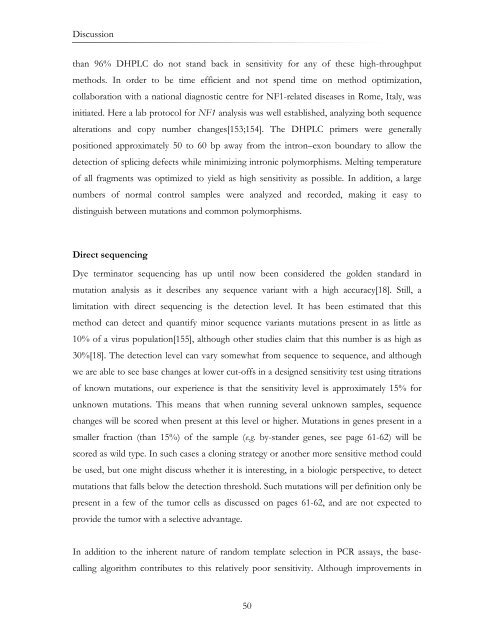Novel genetic and epigenetic alterations in ... - Ous-research.no
Novel genetic and epigenetic alterations in ... - Ous-research.no
Novel genetic and epigenetic alterations in ... - Ous-research.no
Create successful ePaper yourself
Turn your PDF publications into a flip-book with our unique Google optimized e-Paper software.
Discussionthan 96% DHPLC do <strong>no</strong>t st<strong>and</strong> back <strong>in</strong> sensitivity for any of these high-throughputmethods. In order to be time efficient <strong>and</strong> <strong>no</strong>t spend time on method optimization,collaboration with a national diag<strong>no</strong>stic centre for NF1-related diseases <strong>in</strong> Rome, Italy, was<strong>in</strong>itiated. Here a lab protocol for NF1 analysis was well established, analyz<strong>in</strong>g both sequence<strong>alterations</strong> <strong>and</strong> copy number changes[153;154]. The DHPLC primers were generallypositioned approximately 50 to 60 bp away from the <strong>in</strong>tron–exon boundary to allow thedetection of splic<strong>in</strong>g defects while m<strong>in</strong>imiz<strong>in</strong>g <strong>in</strong>tronic polymorphisms. Melt<strong>in</strong>g temperatureof all fragments was optimized to yield as high sensitivity as possible. In addition, a largenumbers of <strong>no</strong>rmal control samples were analyzed <strong>and</strong> recorded, mak<strong>in</strong>g it easy todist<strong>in</strong>guish between mutations <strong>and</strong> common polymorphisms.Direct sequenc<strong>in</strong>gDye term<strong>in</strong>ator sequenc<strong>in</strong>g has up until <strong>no</strong>w been considered the golden st<strong>and</strong>ard <strong>in</strong>mutation analysis as it describes any sequence variant with a high accuracy[18]. Still, alimitation with direct sequenc<strong>in</strong>g is the detection level. It has been estimated that thismethod can detect <strong>and</strong> quantify m<strong>in</strong>or sequence variants mutations present <strong>in</strong> as little as10% of a virus population[155], although other studies claim that this number is as high as30%[18]. The detection level can vary somewhat from sequence to sequence, <strong>and</strong> althoughwe are able to see base changes at lower cut-offs <strong>in</strong> a designed sensitivity test us<strong>in</strong>g titrationsof k<strong>no</strong>wn mutations, our experience is that the sensitivity level is approximately 15% forunk<strong>no</strong>wn mutations. This means that when runn<strong>in</strong>g several unk<strong>no</strong>wn samples, sequencechanges will be scored when present at this level or higher. Mutations <strong>in</strong> genes present <strong>in</strong> asmaller fraction (than 15%) of the sample (e.g. by-st<strong>and</strong>er genes, see page 61-62) will bescored as wild type. In such cases a clon<strong>in</strong>g strategy or a<strong>no</strong>ther more sensitive method couldbe used, but one might discuss whether it is <strong>in</strong>terest<strong>in</strong>g, <strong>in</strong> a biologic perspective, to detectmutations that falls below the detection threshold. Such mutations will per def<strong>in</strong>ition only bepresent <strong>in</strong> a few of the tumor cells as discussed on pages 61-62, <strong>and</strong> are <strong>no</strong>t expected toprovide the tumor with a selective advantage.In addition to the <strong>in</strong>herent nature of r<strong>and</strong>om template selection <strong>in</strong> PCR assays, the basecall<strong>in</strong>galgorithm contributes to this relatively poor sensitivity. Although improvements <strong>in</strong>50
















